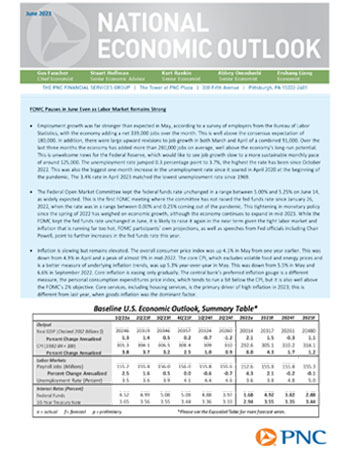La información contenida en este sitio es a saber y entender de PNC Bank, correcta y precisa, pero PNC Bank no declara, manifiesta ni garantiza su exactitud. Cualquier descarga de material contenido en este sitio o de cualquier sitio vinculado a este sitio puede ser una violación de las leyes federales de marcas comerciales y derechos de autor.
Perspectiva económica nacional de PNC
Abril de 2022
Continúa la mejora del mercado laboral estadounidense, a pesar de la sorprendente contracción del PIB Producto Interno Bruto (GDP, por sus siglas en inglés) en el primer trimestre
El reporte de empleo de marzo fue otro reporte sólido, con un crecimiento del empleo durante el mes de 431,000 puestos de trabajo según una encuesta a empleadores. Hubo una gran revisión al alza combinada del crecimiento del empleo en enero y febrero, de 95,000 puestos. El promedio móvil de tres meses de crecimiento del empleo hasta marzo fue de 562,000 puestos de trabajo. El sector privado sumó 426,000 puestos de trabajo en marzo, mientras que el empleo público aumentó en 5,000.
La tasa de desempleo disminuyó del 3.8 % en enero al 3.6 % en marzo. La tasa de desempleo, que se disparó hasta el 14.7 % en abril de 2020 con la pandemia, apenas supera ahora el 3.5 % anterior a la pandemia en febrero de 2020, y ha descendido 2.4 puntos porcentuales en el último año.
La población activa (la cantidad de adultos que trabajan o buscan trabajo) aumentó en 418,000 personas, mientras que la tasa de actividad (la proporción de adultos que trabajan o buscan trabajo) subió al 62.4 % en marzo, frente al 62.3 % de febrero. La tasa de actividad se encontraba por encima del 63 % a principios de 2020, por lo que no se ha recuperado totalmente de la pandemia, pero ha aumentado de forma constante en el último año, casi un punto porcentual.
La economía estadounidense se contrajo levemente en el primer trimestre de 2022, con un descenso del PIB real del 1.4 % a una tasa anualizada, según la estimación anticipada de la Oficina de Análisis Económico. Se trata de la primera contracción del PIB real desde el segundo trimestre de 2020, cuando la pandemia provocó una recesión breve pero muy grave. Aunque el PIB cayó en el primer trimestre, la economía estadounidense no está en recesión.
La demanda subyacente continúa siendo fuerte, con aumentos sólidos en el primer trimestre del gasto de los consumidores, la inversión fija de las empresas y la inversión en vivienda. El crecimiento se reanudará en el segundo trimestre. Los grandes obstáculos del crecimiento en el trimestre procedieron de un déficit comercial mucho mayor, que restó 3.2 puntos porcentuales al crecimiento anualizado; las existencias; y el gasto público. La publicación del PIB se produjo después de que se ultimaran las previsiones de PNC para abril.
La inflación continúa avanzando al ritmo más rápido en décadas. El índice de precios de los gastos de consumo personal subió un 0.9 % en marzo con respecto a febrero, el mayor aumento de precios en un mes desde 2005. La subida de los precios de la energía tras la invasión rusa de Ucrania fue el catalizador del aumento de la inflación; el índice subió un 0.5 % tanto en enero como en marzo. Pero el índice de precios PCE subyacente, que excluye los precios volátiles de los alimentos y la energía, subió un 0.3 % en marzo, mucho más moderado, al mismo ritmo que en febrero y por debajo del 0.5 % de enero.
En términos interanuales, la inflación general medida por el índice PCE fue del 6.6 %, frente al 6.3 % de febrero y el ritmo más rápido desde 1982. Sin embargo, la inflación subyacente del PCE se ralentizó levemente en términos interanuales en marzo, hasta el 5.2 %, frente al 5.3 % de febrero.


